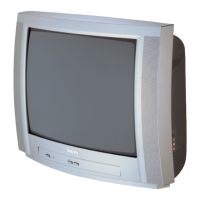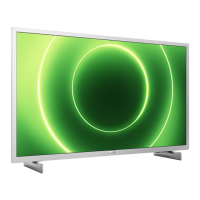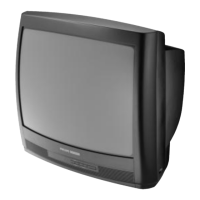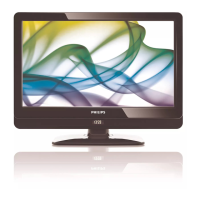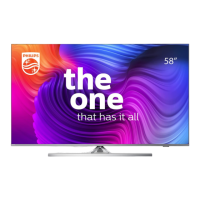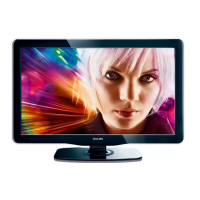
Do you have a question about the Philips POS9002 Series and is the answer not in the manual?
| Smart TV | Yes |
|---|---|
| Operating System | Android TV |
| HDMI Ports | 4 |
| USB Ports | 2 |
| Refresh Rate | 60 Hz |
| Built-in Wi-Fi | Yes |
| Bluetooth | Yes |
| Resolution | 3840 x 2160 (4K UHD) |
| HDR Support | HLG |
| Screen Size | 65 inches |
Explains the new Home launcher, accessing settings, and managing channels.
Describes finding, launching, and favouriting apps and the Philips TV Collection.
Advises reading safety instructions before using the TV for safe operation.
Provides instructions for attaching the TV stand or wall mounting.
Offers tips on optimal TV placement and power cable handling.
Details connecting antenna and satellite dish cables for signal reception.
Provides an overview of the remote control's buttons and their functions.
Explains pairing the remote via Bluetooth and using voice search functionality.
Covers IR sensor, battery replacement, and remote control cleaning instructions.
Details how to switch the TV on, off, or place it in standby mode.
Describes basic TV operations using the joystick key when the remote is unavailable.
Guides on installing TV channels using the Help menu and search functions.
Explains channel lists, icons, sorting, and filtering methods.
Covers tuning, switching, locking channels, parental rating, and subtitle settings.
Details audio language preferences and common interface (CAM) module usage.
Guides on creating, managing, and viewing favourite channel lists.
Explains how to change the sequence of channels within favourite lists.
Covers adding, renaming, and removing favourite channel lists.
Details accessing, navigating, and using Teletext pages and options.
Explains Teletext options, language, and Text 2.5 settings.
Introduces Interactive TV (iTV) and HbbTV functionalities.
Outlines requirements for iTV and guides on its usage.
Details the process of installing satellite channels, including Unicable systems.
Covers satellite installation settings and using CAM modules for descrambling.
Explains channel packages, Unicable system setup, and user bands.
Guides on manually updating channels and adding new satellites.
Covers removing satellites and manual channel installation for experts.
Addresses common issues like finding satellites or poor signal reception.
Details updating and reinstalling channels via antenna.
Covers automatic/manual channel updates and full TV reinstallation.
Explains DVB settings, frequency scan methods, and reception quality.
Guides on manually installing analogue channels and system setup.
Explains copying channel lists between TVs using a USB drive.
Covers checking list version and uploading channel lists to TVs.
Provides connection guide, antenna port info, and details on HDMI ports.
Explains HDMI CEC, CI+ modules for premium content, and smart card insertion.
Covers HTS connection, audio sync, and troubleshooting sound problems.
Guides connecting smartphones, tablets, Blu-ray, and DVD players.
Details Bluetooth device pairing and headphone connection.
Explains connecting game consoles via HDMI or component video.
Covers USB Hard Drive setup for recording and USB keyboard configuration.
Guides using USB flash drives, connecting cameras, and camcorders.
Details connecting a computer to the TV via HDMI or DVI adapter.
Covers connecting the TV to a home network and the internet.
Explains wireless/wired connections and troubleshooting network issues.
Covers static IP configuration and enabling wake-up features via Wi-Fi/Chromecast.
Guides on signing into Google Account and configuring Android settings.
Introduces the Home screen, app access, and Play Next channel.
Covers installing apps from Philips TV Collection and agreeing to Terms of Use.
Details setting privacy preferences for Philips TV Collection apps.
Introduces TV apps, their sources, and installation requirements.
Covers Google Play Movies & TV, Music, and Games functionalities.
Guides on using Play Store, installing apps, and setting parental controls.
Explains how to start/stop apps and add payment methods for purchases.
Details locking apps, 18+ rated apps, and restricted profiles.
Discusses stopping apps and managing cache for optimal performance.
Explains checking TV storage and using USB Hard Drive for extended storage.
Guides on starting and using the TV's built-in Internet browser.
Details various options available within the Internet browser interface.
Explains the TV Menu as an alternative to the Home menu for TV functions.
Guides on how to open and navigate the TV Menu interface.
Explains switching between connected devices and TV tuners.
Covers setting input options and renaming connected devices.
Guides on rescanning connections to update the Sources menu.
Covers network connection steps and Bluetooth device management.
Manages picture styles, adjustments, and advanced visual configurations.
Covers colour settings, ISF calibration, colour control, and RGB modes.
Details contrast modes, HDR settings, and HDR Perfect options.
Covers motion styles, video contrast, gamma, and light sensor adjustments.
Covers sharpness settings, residual image clearing, and screen saver.
Guides on adjusting picture format to fill the screen manually or automatically.
Guides on performing initial easy picture settings adjustments.
Manages sound styles, equalizer, headphone volume, and advanced sound settings.
Explains digital output formats for optical and HDMI ARC signals.
Guides on adjusting audio sync delay for Home Theatre Systems.
Covers turning Ambilight on/off, styles, brightness, saturation, and Hue integration.
Explains adjusting Ambilight brightness and saturation levels.
Guides on configuring Philips Hue bulbs to follow Ambilight colours.
Manages energy saving levels, screen off timer, and switch off timer.
Covers USB Hard Drive setup and USB keyboard configuration.
Explains HDMI CEC operation and setting HDMI Ultra HD signal quality.
Covers HbbTV settings, CAM profile name, and factory reset procedures.
Details clock settings, language preferences, and text language settings.
Guides on viewing installed apps and checking storage space.
Covers universal access features for hearing impaired and blind users.
Details setting codes, parental ratings, and app locking mechanisms.
Details 18+ app lock, restricted profiles, Play Store maturity, and CAM lock.
Guides on viewing media files from a computer or Network Attached Storage.
Covers managing favourite media and viewing popular/last played lists.
Guides on viewing media files from USB flash drives or hard drives.
Details playing videos, folder navigation, and playback control bar functions.
Guides on viewing photos, including 360 photos, and playback options.
Details opening music folders, playing music, and music playback options.
Covers TV Guide requirements, data sources, and how to use the guide.
Explains searching programmes by genre and managing set reminders.
Details how to set and cancel programme recordings.
Explains requirements and methods for recording TV broadcasts.
Covers recording programmes now, scheduling, and managing the recordings list.
Explains setting auto end margin and performing manual recordings.
Explains requirements and methods for pausing and resuming TV broadcasts.
Guides on replaying current broadcasts for a few seconds.
Introduces the Philips TV Remote App for smartphone control.
Explains casting apps from mobile devices to the TV.
Covers AirPlay functionality via apps and MHL mobile device connection.
Outlines requirements for playing games on the TV, including app sources.
Guides on connecting wireless gamepads for enhanced gaming experience.
Explains how to start a game from a connected game console.
Details setting Ambilight to follow video, audio, or colour styles.
Covers turning Ambilight off and enabling Lounge Light mode.
Introduces Top Picks recommendations and agreeing to Terms of Use.
Details how to open and use Now on TV for programme suggestions.
Introduces TV on Demand for watching missed programmes.
Explains renting movies from online video stores and payment.
Introduces Alexa voice control capabilities for TV operations.
Guides on setting up and using Alexa with the TV for voice commands.
Details updating TV software via internet or USB flash drive.
Details how to view the current TV software version and release notes.
Explains how to enable automatic software updates for the TV.
Provides info on open source software and software-related announcements.
Discusses European Energy Label, product disposal, and battery recycling.
Details power specifications and the TV's operating system.
Lists aerial, tuner, digital/analogue video/audio playback specifications.
Provides diagonal screen size, display resolution, and input resolutions.
Details all connectivity ports on the TV sides and bottom.
Lists sound output power and Dolby/DTS audio features.
Covers connections, file systems, and supported media playback formats.
Mentions DLNA certified media servers and the Philips TV Remote app.
Encourages TV registration for benefits, support, and product updates.
Guides on accessing on-screen help, keywords, and downloading the manual.
Provides troubleshooting steps for power, remote, and channel issues.
Details screen care for OLED TVs, including refreshing and image retention.
Addresses issues like no picture, distorted picture, and poor reception.
Troubleshoots sound issues, HDMI, USB playback, and network problems.
Troubleshoots Wi-Fi network, internet connectivity, and speed issues.
Covers changing menu language and accessing online support resources.
Provides contact information for customer support and repair services.
Covers safety regarding electric shock, fire, children, and overheating.
Warns about battery hazards and risks of injury to the TV.
Discusses humidity effects and provides instructions for screen care.
Outlines TV terms of use, warranty, CE compliance, and EMF standards.
Covers terms for Smart TV usage and Philips TV Collection app.
Lists various trademarks including MHL, HDMI, Dolby, DTS, Wi-Fi, and Kensington.
States that all other registered and unregistered trademarks are property of their owners.
